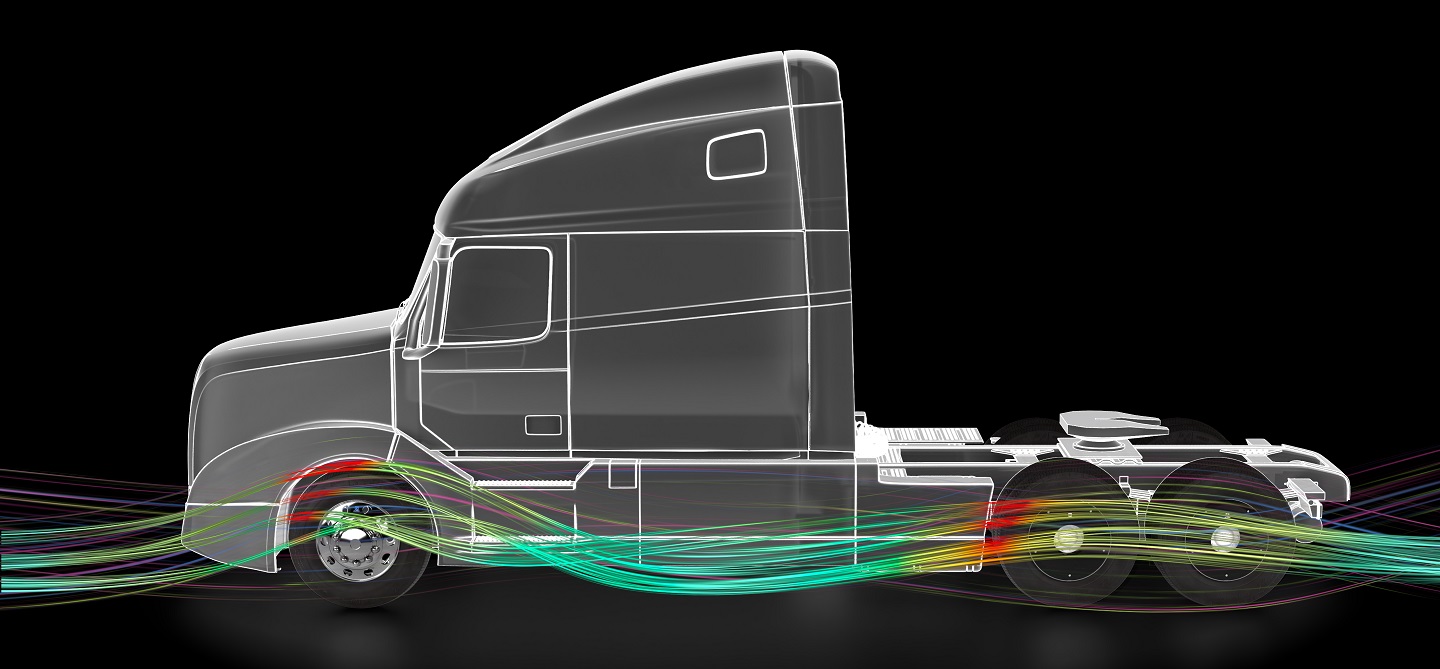Patented Design of Alcoa® Aerodynamic Steer Covers Boost Fuel Efficiency
A fully loaded truck pulling 80,000 pounds down the highway at 65 mph faces considerable resistance as it has to plow through the force of the air that pushes back against it – which is known as drag or aerodynamic resistance. The drag generated from the air against the truck is influenced by multiple factors, including the truck’s shape, speed, weight and aerodynamic features.
Increased aerodynamic drag on a vehicle leads to reduced fuel efficiency and higher fuel costs, as the engine must work harder to overcome the greater air resistance, resulting in more gasoline being consumed over the same distance traveled. Considering that fuel is the largest expense in operating a truck, even small improvements in fuel efficiency can lead to significant savings over time. A truck’s aerodynamic features have one of the biggest direct influences on fuel efficiency. Beyond monetary savings is a reduction in environmental impact. That’s more important than ever as governments and regulatory bodies implement stricter fuel economy standards and emissions regulations.
What Are Aerodynamics?
Aerodynamics is how air flows around an object while it is in motion. It includes understanding the patterns of airflow, which can be laminar (smooth) or turbulent (chaotic). The primary forces in aerodynamics include lift, drag, thrust and weight. These forces impact how objects move through the air. At a basic level, one goal of improving aerodynamics is to keep airflow “attached” to the vehicle. The result is smoother airflow around the vehicle. If airflow becomes detached, it can create extra turbulence. In these situations, the air acts as if the truck is larger than it really is, leading to increased drag and decreased fuel economy. Keeping airflow attached and reducing friction with aerodynamic devices can improve fuel efficiency and lower environmental impact.
Optimizing Aerodynamics
Making trucks and trailers more aerodynamic so they can slice through the air with less effort can include a range of techniques, like retrofitting aerodynamic devices such as side skirts, side extenders, roof fairings, wheel covers and more. Even seemingly small efforts, like maintaining optimal tire pressure, can make a positive impact on aerodynamic profile and improve fuel efficiency.
Aerodynamic devices help the air glide over and around the truck and trailer more efficiently, reducing turbulence and drag that slow the truck down. With less drag, trucks can maintain higher speeds without using more fuel, making the process of transporting goods more efficient and environmentally friendly.
Alcoa® Aerodynamic Steer Cover
A first-of-its-kind approach to aerodynamics, the Alcoa® Aerodynamic Steer Cover is not a traditional full-wheel cover. Its patented design is engineered specifically to push air away from the tire/wheel and vehicle, limiting aerodynamic drag.
Backed by rigorous testing, including computational fluid dynamics (CFD), wind tunnel and test track analysis, the steer cover enhances performance compared to a full-wheel cover or no cover at all, saving 0.39 gallons of fuel every 1,000 miles. Based on 100,000 miles per year and an estimated fuel cost at $3.50/gallon, savings are estimated at $136.50 annually per truck.
Discover exactly how much money your fleet can save with this annual savings calculator.
The steer cover achieves these results by creating a small amount of turbulence through the ramp angle and curvature across the top of the cover, as well as the height of the towers (lug nut covers).
“You actually want a small amount of turbulence so the wind bounces out past the wheel well just a bit and then attaches as fast as possible to the side of the truck so it goes down smoothly. If wind shoots out too far or gets sucked into the well wheel, drag increases,” said Doug Mason, global R&D manager, Alcoa® Wheels. “For anybody on the cutting edge who has already done multiple things to get 5% and 1% savings, they can gain even more. We’ve seen as high .5 gallons per 1,000 miles. Putting two covers on a truck pays for them quickly.”
Secure Attachment System
The adoption of the aerodynamic steer cover is easy to implement for a quick return on investment. Compatible with all 10 x 285.75mm bolt circle wheels, installation is simple in just four quick steps, which are:
- Ensure there are at least six threads exposed and the threads are clean to be able to get full attachment of the steer cover.
- Install the cover by centering it over the 10 studs and nuts.
- Start at the 12 o’clock position installing all nut covers with half a turn.
- Use a star pattern for final tightening, which can be done by hand or using the optional wrench until each nut cover clicks in place.
The steer covers are held securely in place with Alcoa® Hug-A-Lug® technology. Screw-on nut covers provide maximum retention and quality finish while clamp-on nut covers accommodate no stud standoff and mount directly on the lug nut.
Alcoa® Aerodynamic Steer Covers are available in chrome or matte black, so they’re compatible with Dura-Bright® Wheels or Dura-Black™ Wheels.

Learn more about how Alcoa® Aerodynamic Steer Covers reduce drag to save fuel and offer unrivaled finishes for a long-lasting, quality appearance.






